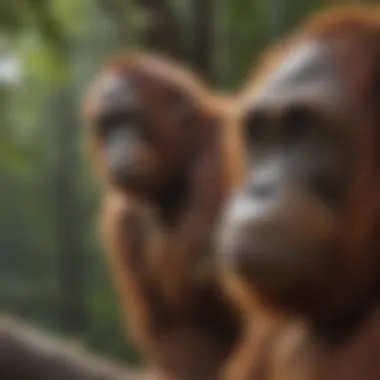Understanding the Endangered Status of Orangutans


Nature Topic Overview
Orangutans are one of our closest relatives in the animal kingdom, sharing about 97% of their DNA with humans. These incredible creatures are primarily found in the rainforests of Sumatra and Borneo. Unfortunately, orangutans are facing serious threats that have brought them to the brink of extinction. Habitat loss, illegal hunting, and environmental changes are just a few of the pressing issues putting these magnificent primates in jeopardy. Understanding these factors is crucial as it helps us figure out how we can work together to save them and their habitats.
Today, as we explore the struggles of orangutans, we aim to connect the dots between human activities and the dynamic environment we all share. This knowledge can ignite a passion for conservation in our hearts and minds, urging families and young individuals to take action.
Fun Facts and Trivia
Did you know that orangutans can use tools? They have been spotted using sticks to extract insects from tree bark! Here are a few more entertaining facts:
- Name Meaning: The term "orangutan" comes from the Malay words "orang" meaning person, and "hutan" meaning forest. So, it literally means "forest person."
- Impressive Swingers: An adult orangutan can swing through the trees at speeds up to 2 miles per hour (that’s faster than some kids sprinting!).
- Loneliness: Unlike many other primates, orangutans prefer a solitary life, often spending time alone rather than in groups.
Visuals are essential for learning! Pictures of orangutans in their natural habitat, as well as tools they use, can help bring these facts to life.
Wildlife Explorations
Exploring wildlife is like opening a treasure chest of wonders. In the rainforest, orangutans share their environment with many other species, like the Sumatran tiger and the Bornean pygmy elephant. These animals all depend on the forest land for survival and contribute to the rich biodiversity of the region.
Related Species
- Sumatran Tiger: Originally roamed across Southeast Asia, but now largely confined to the sumatra Island. Their numbers have drastically declined, making them a critically endangered species.
- Bornean Pygmy Elephant: The smallest elephant subspecies in the world is found only on the island of Borneo. It is also endangered due to habitat loss.
Quiz Time!
What do you think? Which is heavier, an adult orangutan or a Bornean pygmy elephant?
Find out by researching or just take a wild guess!
Environmental Awareness
With the encompassing threats to orangutans and their habitats, it becomes imperative that we understand the significance of conservation. Every little action counts. Even children can play a role in protecting nature. Here are a few impactful ways:
- Spread the Word: Talk about orangutans, their endangered status, and what can be done to help protect them.
- Reduce, Reuse, Recycle: Engage in recycling programs at school and home. It reduces waste and helps keep our environment clean.
- Plant a Tree: Celebrate Earth Day by planting a tree in your backyard or local park. Trees are crucial for many species, including orangutans.
DIY Nature Activities
Let’s get our hands dirty and help nature! Here are a few fun DIY activities related to orangutan conservation:
- Plant a Mini Garden: Create a small garden in your backyard using native plants that wildlife can benefit from.
- Nature Art: Use leaves, twigs, and flowers to create beautiful artwork. Form the shape of an orangutan or other local wildlife.
- Adventure Walk: Go on a nature walk and write down all the different types of plants and animals you see.
These activities can give kids a deeper appreciation for nature and the importance of conservation.
Conservation efforts require the hands and hearts of everyone! By nurturing our environment, we can ensure that future generations get to witness the amazing orangutans in their natural habitat.
For more information, check out resources like Britannica and Wikipedia.
Preface to Orangutans
When we think about the world’s wildlife, orangutans often come to the forefront as symbols of the urgent need for conservation. They aren’t just cute and cuddly primates; they play a critical role in their ecosystems and are indicators of the health of their habitat. This section aims to enlighten readers about these fascinating creatures, guiding them through their ecological importance and the challenges they face today.
The Importance of Orangutans in Ecosystems
Orangutans are known as the “gardeners of the forest.” This isn’t just a catchy phrase; it has real meaning. These primates contribute to the maintenance of their habitats by dispersing seeds. When they eat fruits, they carry the seeds away in their feces, helping to reproduce trees and plants which are vital for other wildlife. Without them, rainforests would struggle to thrive.
Moreover, their presence indicates the overall health of the ecosystem. If orangutans are thriving, it usually means that other species and plants in the area are also doing well.
Overview of Species
Orangutans are primarily divided into two main species: the Sumatran orangutan and the Bornean orangutan. Understanding their differences is crucial, not only for scientific purposes but also for effective conservation efforts.
Sumatran Orangutan
The Sumatran orangutan is distinguished by its darker, longer hair compared to its Bornean cousin. They mainly reside in the northern part of Sumatra, an island in Indonesia. One striking aspect of these orangutans is their intelligence, which leads them to use tools to locate food, build nests, and defend their territory. These behaviors highlight their adaptability and the intricate social structures they maintain.
However, the Sumatran orangutan is classified as critically endangered. With fewer than 14,000 individuals left, this species faces an uphill battle due to habitat destruction primarily caused by palm oil plantations. Preserving their habitat is not just beneficial for the orangutans, it’s essential for the entire ecosystem they inhabit.
Bornean Orangutan
On the other hand, the Bornean orangutan is more widespread but still endangered, with an estimated population of around 55,000. This species is often recognized for its slightly lighter fur and larger body size. Both types showcase remarkable social behavior, such as nurturing their young and forming bonds. Another unique feature of Bornean orangutans is their vocalization; they produce a variety of sounds that create a sophisticated form of communication, indicating their emotional states.


Just like the Sumatran, the Bornean orangutan is also threatened by logging, mining, and agricultural expansion. Different conservation initiatives focus on habitat protection and raising awareness about sustainable practices.
"To truly save orangutans, we must understand their role not just in their ecosystem, but in the broader context of environmental health."
By providing a deeper look at these majestic primates, we inspire readers to take action and stand up for the planet, ultimately ensuring that future generations can learn about and enjoy the wonders of the orangutan.
The Status of Endangerment
The status of orangutans as endangered species is a crucial point in understanding their plight and the overall health of ecosystems where they reside. This subject delves into the hours of conversations happening in ecological circles and among conservationists. It sheds light on why every count of these incredible creatures matters, not just for orangutans themselves but for the entire planet. By comprehending the status of endangerment, we see the interconnectedness of life on Earth and the profound consequences that arise from losing even a single species.
Current Population Estimates
As of the latest data available, the global population of orangutans has dropped to alarming levels. Current estimates suggest that around 55,000 to 65,000 Bornean orangutans are left in the wild, while the Sumatran counterpart teeters at a precarious 13,600 individuals. These numbers are dizzyingly low when you think about it. Only a few decades ago, these populations were considerably larger.
The decline in population can be attributed to various factors, chiefly habitat destruction and poaching. Studies show that the numbers continue to dwindle, often highlighting the urgency for concerted conservation efforts. Keeping track of how many orangutans remain in the wild is essential, as these figures help scientists and conservationists craft effective strategies for protection. \n
"Every number has a story, and every orangutan lost is a history untold."
Criteria for Endangered Species Classification
The classification of orangutans as endangered is determined by specific criteria established by the International Union for Conservation of Nature (IUCN). These include factors such as:
- Population size – As we've seen, the rapidly declining number of individuals puts them in the endangered category.
- Geographic range – The natural habitat of orangutans is getting smaller, restricting their movement and breeding opportunities.
- Threats to survival – Deforestation, poaching, and habitat degradation all contribute to the high risks these animals face.
When a species meets certain thresholds set by the IUCN related to these factors, it gets classified as endangered. For orangutans, being labeled as endangered is not just a title—it’s a wake-up call for humanity to reconsider our actions and repercussions.
Key Threats to Orangutans
The plight of orangutans is deeply intertwined with various threats that jeopardize their very existence. Understanding these threats is crucial as they illuminate how human actions affect the delicate balance of ecosystems. By recognizing and addressing these challenges, we can better advocate for the protection of orangutans and their habitats. This section explores the primary dangers they face, grounded in reality and steeped in urgency.
Deforestation: The Primary Driver
Deforestation represents the most significant threat to orangutans. As forests are cleared for various purposes, orangutans lose their homes, pushing them toward extinction. Each tree felled means one less branch for these majestic creatures to swing from. It's not a pretty picture, and the consequences are dire. Let's examine the factors contributing to this widespread deforestation.
Commercial Logging
Commercial logging is a glaring contributor to the decline of orangutan populations. Companies cut down trees to produce timber and other wood products. This practice is lucrative, but it comes with hefty costs. It decimates habitats, leaving orangutans stranded in smaller fragments of forest. One remarkable aspect of commercial logging is the demand for certain types of timber, like mahogany, which sells at high prices.
However, while timber trade can generate income for local communities, the long-term impacts often outweigh financial benefits. Logging operations frequently pave the way for further destruction, like roads that enable more illegal activities, which is a vicious cycle. So, while logging might seem beneficial at a glance, its contribution to the downfall of orangutan habitats tells a different, grimmer story.
Palm Oil Plantations
Palm oil plantations have become synonymous with deforestation. As the demand for palm oil grows—used in everything from cookies to cosmetics—lush forests are leveled to make way for monoculture crops. The attractive aspect of palm oil is its profitability. It's a big player in the global market, enticing farmers and corporations alike.
Nevertheless, the unique characteristic of these plantations is that they replace rich, biodiverse ecosystems with uniform landscapes. This shift has devastating effects; not only do orangutans lose their homes, but their food sources dwindle as well. The expansion of palm oil plantations represents a deadly choice that carries severe ecological consequences. What may appear as economic opportunity sadly comes at a high price for wildlife, particularly orangutans.
Slash-and-Burn Agriculture
Slash-and-burn agriculture is an ancient practice that is becoming increasingly problematic. Farmers clear land by cutting trees and burning the underbrush, preparing the soil for crops. While it may be an effective method for small-scale farming, it often spirals out of control. More land gets cleared than necessary, further encroaching into orangutan territories.
This approach can yield short-term benefits, but its sustainability is a different kettle of fish. The land can quickly lose its fertility, leading farmers to seek more forest areas. As they chase the ever-elusive fertile ground, orangutan populations dwindle, and biodiversity takes a hit. So, in this scenario, agricultural practices, while meant to support livelihoods, often promote ecological degradation.
Illegal Hunting and Wildlife Trade
Illegal hunting is a dark undercurrent that exacerbates the plight of orangutans. The allure of profit leads many to poach these creatures for pets or traditional medicine. Understanding the depth of this issue is essential, as hunting leaves long-lasting scars on populations already in decline.
Poaching for Pet Trade
The pet trade has detrimental implications for orangutan communities. Young orangutans, who might be charming and cute, are often captured and sold as exotic pets. This not only removes individuals from their natural habitats but also disrupts social structures, essential for their survival.
Selling these creatures is appealing due to their popularity among collectors. However, the heartbreaking reality is that most captured orangutans do not survive long in captivity. This practice highlights the wider societal ignorance surrounding wildlife preservation—a challenge that needs addressing if we are to halt these tragic outcomes.
Traditional Medicine
Traditional medicine practices in certain cultures also contribute to the plight of orangutans. Some people believe that parts of orangutans can cure ailments or bring about good luck. This belief results in poaching, adding pressure to an already strained population.
The mysterious allure of traditional beliefs creates a fierce conflict between cultural practices and conservation. These age-old views resist change, making it crucial to blend education with cultural sensitivity to ensure both conservation and heritage are respected.


Climate Change and its Impact
Climate change presents an overarching threat that compounds the issues faced by orangutans. Altered weather patterns and rising temperatures influence their habitats and food sources. Thus, understanding the nuances of climate change in the context of orangutan survival is essential.
Habitat Degradation
One significant impact of climate change is habitat degradation. As temperatures rise, some areas of the forest become less habitable for orangutans. The ecosystems these animals rely on are shifting in ways that can be catastrophic.
The resilience of orangutans is put to the test as they contend with not only habitat loss through deforestation but also the degradation of existing forests. This situation highlights the need for an adaptive approach to conservation—one that acknowledges the global climate patterns at play.
Alteration of Food Supply
Additionally, climate change disrupts the food supply for orangutans. Fluctuations in rainfall and temperature directly impact fruiting patterns in trees, leading to inconsistent food availability. Since orangutans primarily feed on fruits, any changes to their food sources can lead to malnutrition or starvation.
It's a ticking time bomb that demands our attention. Understanding how food availability intersects with broader environmental changes becomes crucial for protecting orangutans and their habitats. Without intervention, the cycle of decline could spiral beyond control.
Orangutans are much more than just creatures swinging in trees; they're vital parts of their ecosystems that require our understanding and protection to ensure their continued existence.
Human Influence on Orangutan Populations
The impact of humans on orangutan populations is a critical area of concern for conservationists and biologists alike. Understanding how our actions shape the lives of these great apes helps highlight the urgent need for effective measures to protect them. Several everyday activities and broader economic trends negatively affect the survival chances of orangutans, making it crucial for us to grasp these dynamics. It’s not just a matter of saving an endangered species; it’s also about preserving the intricate web of life within tropical forests that sustains countless other wildlife and ecosystems.
Economic Factors of Deforestation
The economic motivations behind deforestation serve as a primary driver of the decline in orangutan numbers. Many regions where orangutans live are being cleared for timber, palm oil, and agricultural development. This rampant deforestation leads to habitat loss which is unfortunately cataclysmic for orangutan populations.
- Commercial logging: Logging companies cut down trees to meet the global demand for wood products. This not only destroys the homes of orangutans but also depletes their food supply.
- Palm oil plantations: The cultivation of palm oil has skyrocketed in recent decades. Forests are leveled to make way for these plantations, resulting in significant habitat destruction. People often overlook the implications of palm oil in many everyday products, from foods to cosmetics.
- Slash-and-burn agriculture: Some local farmers clear lands using a method that removes vegetation quickly. While it may seem efficient at first glance, this practice can be detrimental to the ecosystem and causes the loss of long-term forest cover.
These industries often promise economic growth and new job opportunities; however, the hidden cost is a substantial ecological void left in the wake of progress.
Societal Attitudes Towards Conservation
Human attitudes toward conservation play a pivotal role in either mitigating or exacerbating the plight of orangutans. When society prioritizes short-term gains over long-term sustainability, it runs the risk of neglecting our shared responsibility to protect wildlife. Shifting attitudes is key in the fight against orangutan endangerment.
- Awareness: More often than not, people are unaware of how their choices impact orangutan habitats. Many folks don't even know that palm oil is palm oil or that their morning breakfast could play a part in deforestation.
- Education: Effective educational campaigns can make a world of difference. Teaching young generations about the importance of biodiversity and the role of orangutans in their ecosystems fosters a sense of stewardship.
- Community engagement: Local communities can be vital in conservation efforts. When members of a community take ownership of their environments, they are likely to advocate for changes that protect local wildlife.
By inspiring a shift in mindset towards conservation, we lay the groundwork for policies that can effectively support orangutan populations and promote harmony with nature.
"To save the orangutan is not just to save a species, but to save our connection to the natural world, a legacy we can’t afford to lose."
In summary, understanding the human influence on orangutan populations is essential for crafting effective conservation strategies. By dissecting economic factors and reshaping societal attitudes, we can chart a path toward a sustainable future for these remarkable creatures.
Conservation Efforts
The survival of orangutans heavily relies on a concerted effort in conservation. Protecting these remarkable creatures takes more than just awareness; it involves strategic actions aimed at preserving their habitat and ensuring sustainable coexistence with humans. This section details various aspects of conservation efforts that are vital in securing the future of orangutans.
Protected Areas and Reserves
Implementing protected spaces is a cornerstone of orangutan conservation. Areas like the Gunung Leuser National Park in Sumatra serve as critical sanctuaries. These reserves not only provide a safe haven for orangutans but also protect their habitats from logging and agricultural expansion. When animals have secure spaces, it helps boost their population, providing a better chance for recovery. However, establishing these reserves is just the beginning. There are ongoing challenges in enforcement and management that need continuous attention.
Community Involvement and Education
An empowered community can be a game-changer in conservation. When local populations understand the importance of preserving their environment for future generations and see the benefits of conservation efforts, they become allies rather than adversaries. The following subsections unpack how local engagement and educational initiatives play a role in this transformative process.
Local Engagement
Local engagement is about involving the community in conservation decisions. This grassroots approach allows residents to take ownership of the surrounding natural resources. One key characteristic is the direct participation of local people in monitoring wildlife and protecting forests. This inclusivity is a beneficial choice because it encourages sustainable practices. The unique feature of local engagement is that it fosters a sense of stewardship among community members. However, a potential disadvantage is that without proper training, local initiatives may lack the technical expertise needed for effective management.
Educational Campaigns
Education creates awareness and instills a sense of responsibility. Educational campaigns target various audiences, including schools and local community groups. They aim to teach the importance of orangutan conservation and habitat preservation. One significant aspect of these campaigns is their capacity to simplify complex ecological concepts for young minds. Moreover, key characteristic lies in their ability to reach a broad demographic, making conservation relatable and actionable. However, a challenge can arise in ensuring that the educational materials evolve to remain engaging and relevant over time.
International Organizations and Support
Global cooperation is crucial, and many international organizations step up to support conservation endeavors. Groups like the World Wildlife Fund (WWF) and Orangutan Foundation International provide resources, funding, and technical expertise to local projects. These established organizations bring visibility and credibility, attracting additional support for initiatives on the ground. Their interventions not only focus on the immediate survival of orangutans but also advocate for long-term sustainability by addressing systemic issues like illegal logging and trade.
"Conservation is a team sport; the more, the merrier." - An Environmental Activist


The Role of Technology in Conservation
Technology has come to play a pivotal role in the conservation of orangutans. It's not just about the gadgets; it’s the way they help us understand and protect these magnificent beings and their homes. With the rapid advancements in technology, conservationists are finding new and more effective ways to tackle the challenges facing orangutans. This section delves into two key aspects: monitoring and data collection, and innovative solutions for habitat protection.
Monitoring and Data Collection
Monitoring orangutan populations is crucial for effective conservation. Conservationists need to know where orangutans live, how many there are, and their behaviors to implement the right measures for their protection.
- Camera Traps: These devices are set up in orangutan habitats to take pictures. They help researchers see how many orangutans are around and track their movements. It’s like a sneak peek into their world without bothering them.
- GPS Collaring: Some orangutans are fitted with collars that track their movements using GPS technology. This information is vital for understanding their habitat usage and requirements. It’s like having their own tiny map!
- Drones: Drones are being used to survey vast areas of forest from the sky. They can reveal illegal logging activities and provide vital information about forest cover. The aerial view helps conservationists see where the orangutans might be struggling.
"Technology is not just a tool; it’s a bridge to understanding and preserving wildlife."
Incorporating these tools not only revolutionizes data gathering but also makes it possible to generate reports that can raise awareness and inspire change. Without such effective monitoring, we would be flying in the dark about the orangutan's future.
Innovative Solutions for Habitat Protection
Securing orangutan habitats is another arena where technology shines. With deforestation rampant, innovative solutions are essential for ensuring these creatures can make their homes in the forest rather than on the endangered list. Here are some noteworthy advancements:
- Mapping Software: High-tech mapping tools help identify critical orangutan habitats and plan for their protection. Software like GIS allows researchers to visualize geographic data, ensuring that they understand the full scope of the habitats that need preservation.
- Mobile Apps: Some organizations have developed apps that allow local communities to report incidents of illegal logging or wildlife trafficking. This makes everyone a potential protector of the forest and enables quick action, as they can notify authorities right from their phones.
- Sustainable Technology in Agriculture: New farming techniques reduce environmental impact while enabling local communities to grow crops. These methods often rely on technology to improve yield without sacrificing forest areas.
Using these technological advancements not only helps the environment but also empowers local communities to engage in sustainable practices.
Ultimately, the combination of monitoring and innovative solutions is essential for the survival of orangutans. As we harness the power of technology, we take significant strides towards creating a world where orangutans can thrive.
Future Outlook
The future outlook for orangutans hinges on several key factors that can drastically change their fate. With the current challenges facing these incredible primates, it is essential to understand what is at stake and how different elements can impact their survival. Looking forward, we see potential not just for preserving orangutan populations but for a significant recovery if the right actions are taken.
Potential for Recovery
Orangutans are resilient beings; they have shown signs of adaptability, and there is a sliver of hope for their recovery. Studies have indicated that when suitable conservation measures are implemented, their numbers can rebound. Protected areas, for instance, have proven effective in maintaining stable populations.
Moreover, community involvement in conservation efforts plays a crucial role. Locals who engage in protecting their environment can contribute to a healthier ecosystem. Reforestation initiatives can also help restore degraded habitats, allowing orangutans to reclaim their territories.
To truly capture the potential for recovery, stakeholders must address key issues:
- Strengthening laws to prevent deforestation and illegal hunting.
- Increasing awareness among local communities about the importance of orangutan conservation.
- Partnering with international organizations to provide resources and knowledge for effective conservation strategies.
"While the shadows of extinction loom, proactive measures light the path to recovery."
Role of Young Audiences in Conservation
Children hold the key to a brighter future for orangutans. Their imagination and boundless energy make them perfect advocates for change. Engaging young audiences not only plants the seeds of love for wildlife but also empowers them to take action. The younger generation can significantly influence conservation efforts that lead to long-lasting impact.
Educational programs in schools can cultivate early interest in biodiversity and environmental protection. Activities such as:
- Field trips to nature reserves, showcasing the importance of these habitats.
- Art contests that focus on wildlife, creating emotional connections through creativity.
- Storytelling sessions featuring orangutan tales, imparting values of conservation.
In addition, leveraging digital platforms offers vast potential. Young activists can share their passion through social media, magnifying the conservation message. They can participate in campaigns that draw attention to the plight of orangutans and encourage their peers to contribute.
Ultimately, the role of young audiences in conservation should not be underestimated. They are not just the leaders of tomorrow; they are changemakers today. By inspiring youth, we pave the way for a future where orangutans thrive and ecological balance is restored.
Ending
The conclusion of this article is a crucial moment to reflect on what has been discussed about the endangered status of orangutans. It pulls together various strands of information, connecting the dots between the threats faced by these remarkable primates and the ongoing efforts to protect them. The goal is to not just inform but to inspire action, especially among younger audiences who hold the future in their hands.
By summarizing the key points about habitat destruction, illegal hunting, and the role of community and technology in conservation, we shed light on the pressing need to recognize the urgency of the situation. Protecting orangutans is not simply an environmental issue; it speaks volumes about our responsibility as stewards of the Earth. If we fail to act, we risk losing not only these creatures but also the biodiversity of the ecosystems they inhabit.
The benefits of understanding these complexities are profound. It opens the door for informed discussions about conservation strategies, engages communities in local initiatives, and motivates individuals to participate in global campaigns. Each of us has a role to play, and this conclusion serves as a reminder that the fight to save orangutans is collective, requiring united effort and determination.
"In every struggle for survival, there is the potential for hope and restoration. Together, we can make a difference."
Summary of Key Points
- Orangutans are critically endangered: Habitat loss, primarily due to deforestation for palm oil, poses a significant risk.
- Illegal hunting wreaks havoc: They are often hunted illegally for traditional medicine or captured for the pet trade.
- Conservation measures are vital: Protected areas and community engagement play huge roles in their survival.
- Technology offers new solutions: Innovations in monitoring and habitat preservation provide hope for restoration.
Call to Action
To combat the perilous situation faced by orangutans, everyone is encouraged to take action. Here’s how you can make a difference:
- Educate others: Share information about orangutans’ plight with friends and family.
- Support conservation organizations: Donate or volunteer with groups focused on protecting orangutans.
- Choose sustainable products: Select items that do not contribute to deforestation, especially palm oil.
- Advocate for policies: Encourage local and global leaders to implement stricter laws against poaching and habitat destruction.
By taking these steps, you join a movement that champions the protection of orangutans and their habitat, ensuring future generations can also learn about and experience these incredible animals.







